 |
surfresearch.com.au
history : duke in australia, 1914
|
Duke Kahanamoku's Australian Tour, 1914-1915
| home | catalogue | history | references | appendix |
 |
surfresearch.com.au
history : duke in australia, 1914
|
1. Surf
riding is not something new but has an ancient tradition,
historically comparable with the Greek Olympics.
2.
Surfboard riding is not limited to the benign waves of
Waikiki.
3. Duke
Kahanamoku provided a full critique of the mechanics of
surfing, including
- wave
knowledge, safety and rescue.
- instruction,
including tandem lessons.
- surfboard
construction and design.
- the
principles of the hand shaping.
and
demonstrated by a surfing performance that would not be
eclipsed in Australia for 40 years.
4. Apart
from breaking several current world swimming records, the tour
had a significant impact of the continuing development of
modern swimming technique.
5. For
Australian society, Duke Kahanamoku's visit brought into
question some commonly held views of racial superiority.
Note that for many commentators it has been all too easy to date the beginnings of surfboard riding in Australia to Duke Kahanamoku's 1914-1915 visit, whereas the previous chapter demonstrates that this was not the case.
-see Before Duke 1900 - 1914.
Probably the
most influential work has been Nat Young's History of
Surfing where he noted the arrival of C.D. Paterson's
board in 1912 which "a few local body surfers had tried to
ride, but couldn't" (page 42), and accredits a
photograph on page 47 as "15th January 1915 Duke
Kahanamoku introduces surfboard riding to Australia."
The book has
had numerous editions, the latest in 2009, each new edition
adding an extra chapter, without the early chapters ever
being revised.
- Young: The History of Surfing (1983) and subsequent editions.
As is often
evident in recording history, the story teller may have a
vested interest in securing a position of prominance for a
compatriot, a family member, their club, their association, or
themselves.
For example
Manly surfboard champion, Claude West, confidently proclaimed
in 1939:
"I was
the first Australian to take up surf-board rlding.
...
I Iearnt
on Duke Kahanamoku's board, which he left here after
introducing surf-board riding to Australia before the
war."
- Daily Telegraph Thursday, 9 February 1939, page 7.
Illustrating the racial attitudes of the period, four years before Duke Kanamoku's arrival, the Manly surf carnival featured a item, somewhat less than flattering to Pacific islanders:
"A
spectacular event was the arrival of a raft from the sea
manned by supposed survivors of a shipwreck.
As they
came in on the surf, they were attacked by a band of
cannibals from the beach and just in the nick of time were
rescued by a man-o-war crew in the surf boat.
There was
much firing of guns and several of the niggers dropped as
though shot.
The
proceedings were -julie (?) realistic and the event
brought forth rounds of cheers from the spectators."
-
Unaccredited: Manly Surf
Carnival.
Sydney
Morning Herald, 21 March 1910, page 10.
"Kahanamoku ... was willing to come, indeed anxious to make the trip to Australia."
- Merman
(W. F. C. Corbett): Wonderful
Hawaiian
- Duke Paoa Kahanamoku.
The Daily
Telegraph, Sydney, 30th October, 1912, page ?
This document
was provided courtesy of Ray Moran at the Australian Surfing
Museum and Manly LSC.
Duke's enthusiasm to tour Australia was perhaps in no small way enhanced by an outstanding act of sportsmanship by his closest rival, Cecil Healey, who along with others, consented to a 100 metre repercharge after Duke Kahanamoku and other members of the American team had failed to show for their event.
In October,
1912, a meeting of the NSW Amateur Swimming Association
initiated a formal invitation to Kahanamoku to compete
in various state championships and demonstrate his progressive
swimming style.
A newspaper
article reported on Duke's unusal first name, education, his
rise to competitive prominance and swimming technique.
Duke's
surfriding skills were also noted.
“Should Kahanamoku come to Sydney (he is claimed to be the world champion surf-shooter in Honolulu), he will surely astonish local surfers with is(sic, his) evolutions in the breakers.”
- Merman
(W. F. C. Corbett): Wonderful
Hawaiian
- Duke Paoa Kahanamoku.
The Daily
Telegraph, Sydney, 30th October, 1912, page ?
This document
was provided courtesy of Ray Moran at the Australian Surfing
Museum and Manly LSC.
|
"DUKE" KAHANAMOKU The Hawaiian Swimmer World record holder 100 metres, Time 1 min. 2 3/5 secs. The
Daily Telegraph, |
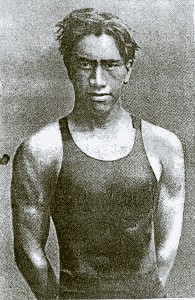 |
Duke's Olympic
success had created a demand for demonstrations of his skills
and in the following years he appeared at several events in
America, on occassions demonstrating surfboard riding and
setting a precedent for the events later organised in Sydney.
Following a
swimming competition at the Los Angeles Athletic Club in July
1913:
"The
great Hawaiian swimmer and six members of the Hawaiian
team spent several hours in Long Beach yesterday.
They came
upon the invitation of Pete Lenz.
They
couldn't resist the surf and the Duke gave a thrilling
exhibition of surfboard riding.
Thousands
of people enjoyed watching him."
-
Unaccredited: Local
Boy
Races Champ.
Daily
Telegram, 12 July 1913.
At the end of 1913, negotiations regarding an Australian tour by Kahanamoku were still being persued:
"Mr. W.
W. Hill, secretary of the New South Wales Rugby Union,
Australian Swimming Union, Olympic Fund Committee, and
general all-round sporting enthusiast, returned to Sydney
yesterday by the R.M.S. Niagara, after a brief visit to
California."
...
Mr. Hill
visited Honolulu, on his way home, to interview Duke Paoa
Kahanamoku, the famous Hawaiian world's champion sprint
swimmer, in regard to a visit to Australia.
Unfortunately,
the
"Duke" has some urgent private business to attend to.
When at
Honolulu, Mr. Hill mastered the art of surf-board riding,
and canoeing in front of the wave; which sport is made
possible by the formation of the Waikiki Beach, which
brings in a long easy roll.
'There
are some fine swimmers at Honolulu besides Kahanamoku,'
continued Mr. Hill, 'and the Hawaiian Athletic Union wants
to send a team to Australia next season.
George
Cunha is the best, and has swam 100 yards in 57 seconds.'
"
-
Unaccredited: Football in
America - Mr. Hill Returns.
Sydney
Morning Herald, Tuesday 23 December 1913, page 4.
The next week,
the Sydney Morning Herald published an extended
article on Waikiki Beach and Kahanamoku's swimming
acheivements, which although unaccredited, was probably by W.
W. Hill.
It described
board and canoe surfing in glowing terms:
"The experience is very pleasant; and, once the art is mastered, everything is forgotten in the keen enjoyment of the exercise."
After an account of the derivation of Duke's name, details of his current seven world swimming records, and a report of shark fishing, the author predicted the probable breaking of further records by Kahanamoku during his projected Australian tour due to the suitability of Sydney's Domain Baths and:
"He should easily acclimatise and the temperature of the water and surroundings generally, should be in the champion's favour when he visits us in December next."
- (W. W.
Hill): The
Home
of the Board Surfer - An Australian's Impressions.
Sydney
Morning Herald, Wednesday 31 December 1913, page 5.
It is likely that Hill's surfriding experiences at Waikiki and these newspaper articles, to some extent, contributed to an expectation that Duke would replicate his boardriding skills when he arrived in Australia.
- Cecil
Healey: Swimming.
The Referee,
2 December 1914, page 11.
George Cunha
was possibly a member of the Outrigger Canoe Club and/or the
Haui Nui Club, Waikiki.
Obliquely, one
of the many surfing breaks at Waikiki is called Cuhna
Surf.
Unfortunately,
despite accompanying Kahanamoku on several American tours, a
substantial competitve record, and significant swimming
performances while in Australia, there are no Australian
reports of his boardriding skills, although Cuhna did compete
in an alarm reel race in the surf at the Cronulla carnival on
the 7th February 1915.
-
Unaccredited: Cronulla
Surfing.
The St.
George Call, 13 February 1915, page 5.
Before departing for New Zealand, there was a brief report that suggested Cuhna may have shaped surfboards in Australia:
"the Hawaiian party were to ... auction(ing) several surf boards made by themselves.”
-
Unaccredited: Swimming -
Kahanamoku v Longworth.
Sydney
Morning Herald, 26 January 1915, page 10.
Retrospectively, New Zealand's Poverty Bay Herald recalled in December 1915 that at Lyall Bay both Cunha and Kahanamoku gave an "exhibition of the art of riding the surges".
-
Unaccredited: Untitled.
Poverty Bay
Herald, Volume XLII, Issue 13875, 24 December 1915, page
2.
The role of George Cunha remains an untold story in the surfriding exhibitions of 1914-1915.
Francis Evans replaced Mr W.T. Rawlins, president of the Hawaiian Amateur Athletic Union, who was initially to lead the tour.
-
Unaccredited: Kahanamoku
and Party.
Sydney
Morning Herald, 9 December 1914, page 6.
The arrival in was eagerly anticipated, Kahanamoku's 1912 Olympic rival and now a journalist for The Referee (Sydney's premier sporting newspaper), Cecil Healey, wrote:
"As the due date of his arrival (Monday next) draws nigh, so does the excited state of enthusiasts' feelings become more apparent."
- Cecil
Healey: Kahanamoku,
World's
Swimmer Expected in Sydney Next Week.
The Referee,
9 December 1914, page 1.
Not only
swimmwers, but local surfriders had reason to be excited about
the Hawaiian's visit.
Aware of
Kahanamoku's world wide fame as a surfboard rider, probably
aware of Duke's surfboard riding exhibitions in California and
possibly enhanced by the experience of W.W. Hill at Waikiki in
1913, while the Hawaiian visitors were in transit arrangements
were already in motion to have Duke Kahanamoku perform similar
feats while in Sydney.
"An arrangement is being completed by which opportunity will be given to surf patrons to view his work with the board on our ocean beaches."
-
Unaccredited: Swimming -
Kahanamoku's Visit.
Sydney
Morning Herald, Wednesday 2 December 1914, page 6.
The New South
Wales Amateur Swimming Association prepared advertising
posters promoting his appearance at events on the 2nd, 6th and
9th January, 1915, which featured Duke Kahanamoku's surfing
prowess and were variations on the surfriding image used on
advertising for the Mid-Pacific Carnival at Honolulu in early
1914.
The original
poster was based on a 1912 photograph by A. R. Gurrey Jr., see
above.
 Kampion: Stoked (1997) page 38. Credited to Bishop Museum |
 Thoms: Surfmovies (2000) page 22. |
The day after
the arrival of the Hawaiian competitors, the Sydney
Morning Herald published profiles of Kahanamoku and
Cunha, an account of the official welcome, and a projected
itinerary.
At the Hotel
Australia Duke made reference to the extended delay before he
was able to visit Australia:
"Duke Kahanamoku said he had been looking forward to this visit for the last two or three years."
At this point, carnivals in Melbourne were not on the agenda:
"Victoria, on the score of expense, has declined a visit."
Following previous announcements (SMH, 2 December 1914, page 6) plans were in train to present surfriding exhibitions, but only after appearances at the swimming carnivals in Sydney and Brisbane.
"After
the Sydney swimming carnival, the champion goes to
Queensland, where he will appear at several towns.
Then he
returns to Sydney, and will give a second display.
On this
occasion the Swimming Union will probably in arrange for a
surf display, when the champion will be seen on the
surf-board.
Matters
in this direction have not yet been finally arranged."
-
Unaccredited: Kahanamoku -
Champion Swimmer Arrives.
Sydney
Morning Herald, 15 December 1914, page 4.
Cecil Healey reported on the official reception for The Referee.
"The
tourists were officially welcomed at the Hotel Australia
at 5 o'clock on Monday afternoon.
Followers
of the sport congregated in great force.
It was
the largest and most representative assembly of natatorial
enthusiasts ever seen in Sydney.
The
guests were recorded a magnificent reception, the hero of
the occasion, Duke, of course, being specifically
signalled out."
 |
 |
|
The fastest swimmer in the world, photographed at the Sydney domain Baths two hours after his arrival in Sydney." |
He secured second place in most of the Pacific Coast Championships, and can do 100yds in 57sec. He is one of the Honolulu party now in Sydney." |
"They are members of the Hui Nalu Club, and the party will attend the Randwick and Coogee gala to-night, and the Sydney-Melbourne contest on Saturday."
-
Unaccredited: Swimming-
Kahanamoku's Arrival.
The Sydney
Morning Herald, Wednesday 16 December 1914, page 6.
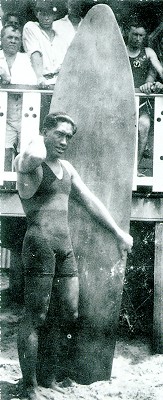 |
Board Freshwater Clubhouse, Sunday 10th January 1915. Compare
and contrast the nose template of this board
FIX
THESE LINKS |
He was accommodated at Boomerang Camp, Freshwater, were he could experience Australian beaches and hopefully exhibit his renowned surfing skill.
By this time body surfing had become common on Australian beaches, actively promoted by the Surf Life Saving movement, and although boards were being used in the surf there was some doubt that Duke would be able to replicate his Hawaiian performance in local conditions.
Whereas in ancient Polynesia the surfriding elite were largely members of the royal class who, presumably, rode surfboards built by artisan canoe builders; in the twentieth century, in a tradition beginning with Duke Kahanamoku, elite riders were at the forefront of board design and construction.
- Finney and Houston: Surfing (1996) pages ?
A surfboard billet in sugar pine (Pinus lambertiana) was hastily prepared, which may have had the template cut before Duke, “proving himself a fine craftsman”, prepared the rail and bottom shape, according to one report with a concave section in the bottom.
- Maxwell: Surf (1949) page 236.
This appears to be confirmed by Reg Harris:
“A
timber firm, George Hudson’s, donated a piece of sugar
pine 9 ft long, 2 ft wide and 3" thick.
The firm
did the rough cutting to Duke’s instructions then he
finished off the finer designing of the bottom of the
board, to give it lift on a wave.”
- Harris: Manly LSC (1961) page 54.
After shaping, the board finished at 8 foot 8 inches long and 23 inches wide.
- These
dimensions personally measured at the Freshwater Surf Life
Saving Club, 2005.
The Daily
Telegraph, Friday 25 December 1914 , page 7
reported: “8ft. in length, 3ft. in width”.
In Nat Young's
Book of Surfing
(1979) and his Surfing
Fundamentals (1985) the dimensions are noted as
3.6 m x 61 cm x 7.5 cm x 31 kg (11 ft 10" x 24" x 3" x 68.3
lbs.).
This is
possibly a typographical error (twice?) as 2.6 m is close to
the correct 8 ft 8".
For a full
colour image of the board, see Phil Abraham: Hidden
Valley
Longboarding Magazine,
Edition 18, November - December 2001, page 35.
Photographs
by Nathan Smith.
Given the
technology of the day, presumably, after cutting the template
with a hand saw the board was rough shaped with an adze and a
draw knife then finished with various grades of sandpaper.
It is also to
be expected that several coats of a natural oil and/or marine
varnish were added to the board to prevent the timber from
becoming waterlogged.
- see Snow
McAlister: Sprint
Walker, Solid Wood Boards and Victorian Surfing.
Tracks
magazine, Sydney, circa 1972.
Reprinted in The
Best
of Tracks, 1973, page 191.
Sugar pine was not the preferred timber for Hawaiian board building.
“The
board used by Kahanamoku weighed 78lb, and was sugar pine.
He would
have preferred redwood, but a properly seasoned piece of
that particular timber, sufficiently long, could not be
procured in Sydney.
The
necessary shape is almost that of a coffin lid, with one
end cut to very nearly a point.
The surf
riding board is thicker at the bottom than at the top,
tapering all the way.”
- W. F.
Corbett: Wonderful
Surfriding- Kahanamoku on the Board.
The Sun,
24th December 1914, Page 6.
Note there is
considerable variation in the reported dimensions, for example
the surfboard weight in this and the subequent reports.
In interviews with the press, Duke made it clear that light-weight was a critical feature that improved surfboard performance:
“Then
too, Kahanamoku was at disadvantage with the board.
It
weighted almost 100lb, whereas the board he uses as a rule
weighs less than 25lb.”
-
Unaccredited: Surf-Board
Riding : Kahanamokus's Display.
Sydney
Morning Herald, 25 December 1914, page 7.
The board
appears in several photographs taken during the tour and the
template is, compared with all the other boards associated
with Kahanamoku, unusual.
Specifically,
the narrow nose template is uncharacteristic of most boards
produced after the tour despite the reported influence of
Kahanamoku’s design:
“Sid 'Splinter' Chapman (at Coolangatta, Queensland) could still recall the dimensions sixty years later ‘because the design that the Duke used was the best.’ “
- Harvey: Surfing History of Queensland (1983) page 8.
The template is certainly different to the “surf shooting board” shaped by Oswald Downing of Manly in 1917, currently on display at the SLSA headquarters at Bondi Beach.
- see Catalogue #175
Downing, a trainee architect, may have also been responsible for drawing up plans for the solid wood board printed and widely distributed by the Surf Life Saving Association of Australia.
- SLSAA: Handbook (1932) page 169.
One reasonable explanation for this variation is that the template of the Freshwater board was not strictly Duke’s design, but was incorporated into this first effort by the tradesmen at Hudson’s.
While the
board has immense historical significance, it is likely that
other boards subsequently shaped in Australia by Duke were the
actual models upon which local builders based their designs.
Following
personal instruction by Duke Kahanamoku in surfboard riding at
Freshwater, Fred Williams and Harry Hay commented :
"we've already ordered a board each … and we are going to master that game beyond any other."
- W. Corbett:
Kahanamoku
in
the Surf.
The Sun,
12 January 1915, page 7.
There is an
implication that these boards are to be ordered directly from
Kahanamoku.
A report in the
Sydney Morning Herald implies there were several boards
built during January and may have included one shaped by
Duke’s companion, George Cunha, although this is the only
currently known reference to his association with surfboard
riding during the tour.
“The executive had practically arranged another method of raising a sum for patriotic purposes for Friday 19th (February, 1915), at which the Hawaiian party were to be made the means of adding to the price of admission by auctioning several surf boards made by themselves.”
-
Unaccredited: Swimming -
Kahanamoku v Longworth.
Sydney
Morning Herald, 26 January 1915, page 10.
Presumably, there were vigorous attempts to secure seasoned redwood billets of suitable dimensions to build these later boards, one of which made its way to Cronulla, the property of ex-Manly surf-shooter, Ron “Prawn” Bowden.
"The Duke's board later became the property of noted club member, Ron "Prawn" Bowden, who sold it to Fred Locke, who in turn, signed it over to the inimitable Jack McTigue."
- W.G.
Marshall: The
Cronulla SLSC Story, Part 2.
Cronulla Surf
Life Saving Club: Cronulla Surf Scene
Volume 1 Number
2 January, 1968, page 7.
It is posssible that the board ridden by Kahanamoku at Cronulla, 7th February 1915, was not the Freshwater board, but another shaped from redwood for the occassion.
In 2008, a possible second board, the template substantially different to the Freshwater board, was unearthed:
"Found
in Australia at the Hordern estate, the board pictured
here is perhaps one of the most astonishing surfing relics
to ever surface.
This
solid ten foot wood board was presented by Duke Kahanamoku
in 1915 to Alfred Roy Hordern as a gift of Aloha in
appreciation for his family's hospitality during a visit
to Australia."
- US
Online Surf Auction 2008, item description and images
subsequently printed in:
Winniman: Vintage
Surfboards (2008), pages 10 and 11.
While Alfred Roy Horden was noted for his "exuberance and recklessness", there is no record of his surfriding exploits in the family's authorised history and it is reported that he enlisted in the army in September 1914, several months before Duke arrived in Australia.
- Lesley
Horden: Children of One Family.
The Sory of
Anthony and Ann Hordern and their descendants in Australia
1825-1925.
Retford Press,
Sydney, 1985, pages 219 and 334.
If the board
was not gifted, as claimed, certainly the Horden family were
financially capable of paying the high price these boards no
doubt fetched.
However, their
connection with surfriding at Palm Beach is not established
until 1921 and at this time they had the facilities to have
surfboards constructed by in-house cabinet makers such as
Buster Quinn.
- Brawley: Palm Beach
SLSC (1996) pages 12-13.
- Brawley: Collaroy SLSC
(1995) page 48.
Ideally, this board’s provenience awaits further documentation.
It is possible that Duke the test rode his sugar pine board during the week before the first exhibition at Freshwater.
The Freshwater board was later handed over to George and Monty Walker of Manly who:
“because of the fine work Claude West had done in popularising surfboard riding, eventually gave it to Claude West, and he still has it, a prized possession.”
- Curlewis,
Adrian: Notes on surfboard riding prepared by S.L.S.A.,
circa 1948, page 2.
Papers
pertaining to C. Bede Maxwell’s Surf: Australians Against
the Sea, 1949.
Mitchell
Library, Sydney, ML MSS 196.
Claude West, a
youth of 15 at the time of Kahanamoku’s visit, became the
leading local surfboard rider.
Originally a
member of Freshwater SLSC, he later moved to the Manly club.
He dominated
SLSA surfboard events until 1924-1925, when West’s mantle as
the premier performer passed
on to another
Manly club member, “Snowy” McAlister.
Claude West
donated the board to the Freshwater SLSC in 1953 where it
remains to this day.
Alf Henderson:
Boards.
in Myers: Freshwater LSC
(1983) page 56.
"The New
South Wales Swimming Association has arranged for a
display by Duke Paoa Kahanamoku at Freshwater on Wednesday
morning, at 11 o'clock.
The
famous swimmer will give an exhibition of breaker shooting
and board shooting."
-
Unaccredited: Swimming - Surf
Display by Kahanamoku.
Sydney
Morning Herald, 22 December 1914, page 12.
Clearly the swimming officials were aware of the construction of the Freshwater board and its (probable) test riding in the previous week for such an announcement to be made.
While the NSW
Swimming Association arranged this exhibition to promote the
upcoming swimming carnivals on the back of the Duke surfriding
image used in their promotional material (see above), it was
intended to be a private demonstration for the local press,
and not a public performance.
Since they had
Duke Kahanamoku under exclusive contract and were promoting
his first public appearance as 2nd January at the Domain
Municipal Baths, the press announcement was considered
regrettable and the event was cancelled.
Duke and his
board did not make an appearance, much to the disappointment
the sizable crowd.
In that
afternoon's The Sun, W.F. Corbett reported:
"The
swimming authorities have heard that through the
publication of a paragraph yesterday to the effect that
Kahanamoku would give an exhibition in the surf at
Freshwater, Manly, some 2000 or 3000 people who assembled
there to watch the show were disappolnted.
The
famous Hawaiian did not put in an appearance, and he was
not expected to do-so by those controlling his visit to
this country.
The
association wishes it to be made known that the "Duke's"
first appearance in public will take place on the opening
day (January 2) of the championship carnival at the
Municlpal Baths, Domain.
The
announcement of any other arrangement with Kahanamoku as
the central flgure has not that body's authority."
- W.F.
Corbett: Fast
Swimming - Kahanamoku Did Not Show.
The Sun,
December 23, 1914, page 5.
Writing a week later Cecil Healy confirmed that the exhibition was only intended as a private demonstration and the public announcement that attracted a large crowd caused the event to be postponed.
"Representatives
of
the Press were invited to witness a private exhibition of
surf-board riding by Kahanamoku at Freshwater on Thursday.
It was to
have been the previous day, but the intention accidentally
became public property, and as several thousand people
were attracted to the vicinity, Association officials
decided to postpone it."
- Cecil
Healey: Swimming
...
Kahanamoku and Surf Board.
The Referee,
30 December 1914, page 16.
The Sun, published that afternoon, was first with the story, the introductory comments less than subtlety referring to the confusion created by the contractual difficulties:
"One
could hear , in the imagination the roars of applause with
which thousands of Australians might have greeted
Kahanamoku 's display at Freshwater, Manly, this morning ,
had the fact that it was to take place been made public.
As it was
there were only a few pressmen, some members of the New
South Wales Amateur Swimming Association, and the casual
Freshwater bathers present."
- W.F.
Corbett: Wonderful
Surfriding- Kahanamoku on the Board.
The Sun,
Thursday 24th December 1914 page 6.
After describing the board, see above, Corbett noted that Duke's surfboard paddling speed cleary out-performed experienced swimmers:
"Kahanamoku's
control
of the improvisation was wonderful, he handled it like a
toy and went out fully a quarter of a mile, riding
some breakers and dashing through others with such speed
that he completely mystified Messers. W. W. Hill and Hoy (sic),
who entered the water with him.
...
Not at
any time in the race seaward did either of the swimmers
hold the islander for a moment, and he soon away by
himself."
- W.F.
Corbett: Wonderful
Surfriding- Kahanamoku on the Board.
The Sun,
Thursday 24th December 1914 page 6.
"Hoy"
is undoubtedly a printing error and refers to Harry Hay who
would have a long term relationship with Kahanamoku.
Despite less
than ideal conditions and an unfamiliar board, the exhibition
was impressive:
"(He) ... caught the breaker he wanted , and paddling along for a while rose to one knee first, then became gradually erect and reached the crest to shoot foreword with astonishing speed and marvellous balance considering the troubled condition of the motive power.
When the
force beneath him was spent, he plunged into the sea, and
picking up his board went off to try again.
Always
was the nose of the raft, if it might be so called, kept
tilted upwards, whether while shooting or forced against
the breakers.
When the
surf rider found his board hanging he stooped and paddled
till it darted forward once more.
Twice he
managed to traverse 100 yards or more, and several times
20 or 30 yards were covered.
...
As
showing how much second nature it was to him, Kahanamoku
stood on his head a couple of times, and even turned his
back to the direction in which he was going, and posed.
Lying
flat on the board, the Hawaiian caused it to describe a
half-circle or turn completely round without spoiling the
shoot."
- W.F.
Corbett: Wonderful
Surfriding- Kahanamoku on the Board.
The Sun,
Thursday 24th December 1914 page 6.
The next day
similar enthusiastic articles appeared in the morning papers.
While The
Telegraph article was brief, it was accompanied by a
photograph of Duke cutting left on a substantially sized wave
in what is clearly less than ideal conditions.
The report
doubled the length of the longest ride and noted that several
local surfers attempted to ride the board.
"On one
occassion, however, Kahanamoku negotiated fully 200 yards
before he turned.
He also
performed some acrobatics, and once stood on his head on
the board.
Several
enthusiastic surfers amoungst the spectactors endeavored
to emulate the feats of the Hawaiian, but mostly the board
either shot from under them or turned over."
-
Unaccredited: Acrobatics
in
the Surf.
Daily
Telegraph, Friday 25th December 1914 page 7. Image
below.
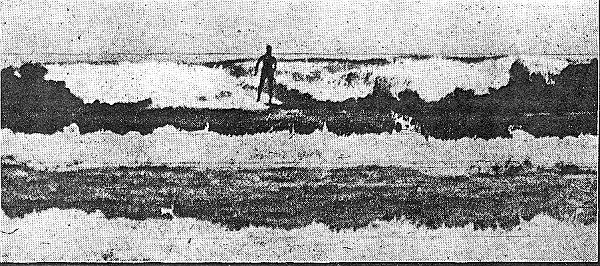
"On a
couple of occassions he managed to shoot fully 100 yards
and then he cleverly demonstrated what could be done.
He turned
completely round, then lying flat on the board, he raised
himself on his hands and swung the board from front to
back and back to front, finally again standing straight
up."
-
Unaccredited: Surf-board
Riding : Kahanamoku's Display.
Sydney
Morning Herald, Friday 25th December 1914 page 7.
Importantly, the report held out the prospect of future public exhibitions:
"If the
condition of the water is favourable when Kahanamoku makes
his public appearance in
surfboard
riding in Sydney it is sure to be keenly appreciated."
-
Unaccredited: Surf-board
Riding : Kahanamoku's Display.
Sydney
Morning Herald, Friday 25th December 1914 page 7.
Six days after
the Freshwater demonstration, another article appeared in the
Referee (which was published weekly) but unfortunanely
the Kahamamoku's Olympic rival and journalist, Cecil Healy,
was not in attendence and his report is largely based on the
previous accounts.
However it
appears that he did discuss the exhibition with several
spectators:
"A
number of our leading surfers were spectators of the
display, and from what I can gather the general impression
amoungst them was that he did wonderfully well under the
circumstances, but they feel sure it merely amounted to an
indication of what he is capable of doing under more
favorable conditions.
They have
no doubt that when he has the opportunity to adapt himself
to the vagaries of our surf, and strikes a suitable day,
he will be able to do things of a really sensational
nature."
- Cecil Healy:
Swimming
... Kahanamoku and Surf Board.
The Referee,
30 December 1914, page 16.
In the many
published accounts of the Freshwater exhibitions the correct
dates have eluded most (all?) commentators, many adopting a
flexible "summer of 1915".
In his
excellent Surfmovies
(2000) page 22, Albie Thoms came close by nominating "11.00
am Wednesday 23" for the first private exhibition,
unfortunately based on the Sydney Morning Herald announcement
for what proved to be the cancelled event.
- SMH,
23 December 1914 p ?,
- Daily
Telegraph, 29 December 1914, p 3
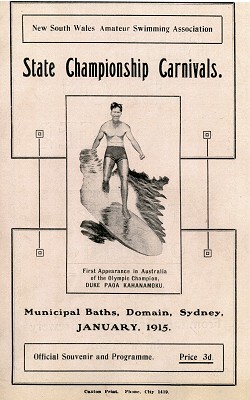 |
State Championship Carnivals. First Appearance in Australia of the Olympic Champion Duke Paoa Kahanamoku. Municipal Baths, Domain, Sydney, January 1915. Official Souvenir and Programme. Price 3d. Caxton Print, Phone City 1419. |
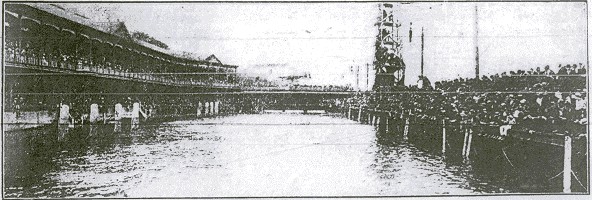
- The Referee, 6 January 1915, page 16.
The record was reported world wide, including an article in the New York Times.
- New York Times, 14 February 1915, Sports Section, page S3.
At the formal dinner following the Domain Carnival the Hawaiian swimmers made a strong impression, Duke honouring the occasion with a song accompanied with ukelele:
"The
visitors were not such accomplished speakers as swimmers,
though it is possible that Messrs. Kahanamoku and Cunha
are gifted enough when they speak in the native tongue,
for no one present was able to interpret the compliments
they gave voice to with wreaths of smiles.
The Duke
and his comrades introduced a novelty by substituting for
the speech a song, with the Duke playing the accompaniment
on his mandolin.
Though
all present did not hear this clearly, it was a remarkably
popular innovation and led to an encore."
-The Cynic: A Few
Remarks on Swimming.
The Referee,13
January
1915, page 15.
" 'Surf
shooting is a new pastime here,' said he.
'With us
it is old - as old as the hills, perhaps.
Shooting
on a board and in a canoe must have started further back
than body shooting."
He observed the great popularity of surf shooting in Australia, although noting the superiority of the skills of Hawaiians:
"You have hundreds more surf shooters at work in one day around Sydney than we see in a week, or perhaps a much longer stretch of time, at Honolulu, but I think the old island has the pastime at greater perfection, which is only to be expected considering its antiquity with us."
Duke was enthusiastic and technically astute about the thrills of surfriding, commenting on outrigger canoe and board surfing:
"(At
Waikiki) the facscinating sports of surf-canoeing and
surf-board riding are indulged in by man, woman, and
child, who insist that they have the most exhiarating and
fascinating pastime known.
The canoe
is cunningly turned before a breaker near the edge
of the reef till it is picked up like a feather on the
inclined plane of the front of the wave, and borne
with remarkable speed - frequently right to
shore.
The
board is worked on the same principle, but its control
calls for much greater skill."
and modest when assessing his own ability:
"There
are numbers of high class surf-shooters in Honolulu, and
some white people amoung them, but, as with every other
game, a few can do better than the great majority.
It was
with the few I delighted to be."
The interview concluded with a discussion of Duke's ear problems, which required the use of ear plugs and occasionally medical attention, however:
"Before
starting for the 100 yards championship of New South Wales
last Sunday afternoon
Kahanamoku could only plug one ear.
It would
not have paid to be deaf to the starter's signals."
- W.F.
Corbett: Kahanamoku
Talks.
The Sun,
Friday 8th January 1915 page 6.
"Kahanamoku,
the
Hawaiian swimmer visited Freshwater yesterday morning,
where he gave some fine displays of surf-shooting.
In the
afternoon be treated the thousands of spectators on the
South Steyne Beach to a highly interesting and clever
exhibition of board and ordinary surf-shooting."
-
Unaccredited: Kahanamoku
in the Surf.
The Sun, 11th
January
1915, page 6.
|
Freshwater Clubhouse, Sunday 10th January 1915. S. Mound, club captain with F
insignia Myers: Freshwater LSC (1983) page 17. |
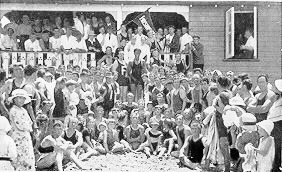 |
"The
Hawaiian spent the morning at Freshwater, where he had a
favorable easterly roll, and what he did there in the way
of board and surf shooting surprised every spectator.
He, as he
put it himself, 'got it right' several times, and
consequently was, on each occasion, seen at his best."
- W.F.
Corbett: Kahanamoku
in
the Surf.
The Sun, 12th
January
1915, page 7.
As well as body and board surfing, Duke gave instruction to two noted surf swimmers, Fred Williams, who had learnt his surf-shooting skills from Manly's Tommy Tana, and Harry Hay, who was also present at the previous Freshwater exhibition.
"Messrs.
Fred Williams, our champion surf shooter, and H. M. Hay,
the speedy Manly swimmer, who 'did fifty-nine' in his heat
of the inter-club handicap on the first day of the recent
carnival, were invited by Kahanamoku to 'get aboard' with
him, and they speak of the experience as thrilling.
'Now
stand up!' ordered the controller of the frail craft when
the proper moment arrived, and then - 'well we've already
ordered a board each,' said the pair of enthusiasts
yesterday, while talking of what occurred, 'and we are
going to master that game beyond any other.'
Kahanamoku
is
not anxious to keep his secret to himself.
He went
to considerable trouble explaining the how and why of his
pet pastime, and it will not be his fault if we do not
have Fred Williams instructlng all desirous of learning
the mysteries of this new to us surf play, as he taught so
many the art of body shooting.
- W.F.
Corbett: Kahanamoku
in
the Surf.
The Sun, 12th
January
1915, page 7.
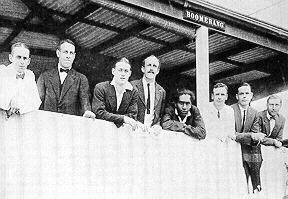 |
Fred Williams, first local bodysurfer (moustache), Harry Hay, Olympic swimmer (to his right). Don McIntyre, far left. 'Boomerang' camp, Freshwater Beach, Sunday 10th January 1915. Note
swimsuit drying on rail, left. |
|
Harry Hay, Olympic swimmer, to his left. Don McIntyre, far left. Boomerang Camp, Freshwater, Sunday 10th January 1915. Longhurst:
Lifesaver
(2000) page 16. |
 |
"The change in the afternoon to go to South Steyne did not suit board-work so well, and the performer was consequently not seen to the same advantage as in the morning, still he gave an exhibition which apparently delighted the great crowd looking on."
- W.F.
Corbett: Kahanamoku
in
the Surf.
The Sun, 12th
January
1915, page 7.
Futhermore, the display was mared by the appearance of a number of local surfers, most probably surfboard riders, eager to share some of the public recognition.
"The
breakers were favorable for the pastime, and the Honolulu
champion made some magnificent returns to the shore
standing on his big surfboard.
He was
however, greatly impeded on this occasion by local
surfers, who wished to give exhibitions of their own at
the same time.
Nevertheless,
his
performance was a revelation to the big crowd in the
vicinity."
-
Unaccredited: Kahanamoku
in the Surf.
The Sun, 11th
January
1915, page 6.
Given the
earlier contractual confusion in respect of the Swimming
Association, the status of this day's events is unclear.
While well
attended and extensively covered by the press, they do not
appear to have been promoted in the Sydney press, although
there may have been some notice in the local papers.
(Unfortunately
copies of The Manly Daily are not available for this
period.)
Critically, it
is unknown if the Freshwater and Manly clubs, who no doubt
played a significant role in organising the exhibitions,
charged a fee to the spectators for what the Swimming
officials would consider a "public performance", as was the
case at the Dee Why and Cronulla carnivals in early February.
For these
appearances and Kahanamoku and Cunha's attendence at
interstate swimming competitions the Swimming Association
extracted a payment of £25.
"During the Queensland, Melbourne and New Zealand visits the New South Wales Association is to receive £25 for each show taklng place."
- W.F.
Corbett: Kahanamoku
in
the Surf.
The Sun, 12th
January
1915, page 7.
As the Dee Why carnival was described as the "first public appearance in the surf", it is possible that the exhibitions at Freshwater and Manly resulted from a combination of the enthusiasm of Duke and the local life saving clubs, and a desire by swimming officals to mitigate any residual public ill-feeling following the cancellation of the display of the 23rd December 1914.
- Announcement
of the upcoming Dee Why Exhibition.
Unaccredited: Swimming -
Kahanamoku's Return.
Sydney
Morning Herald, 3rd February 1915, page 3.
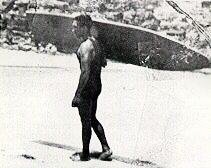 |
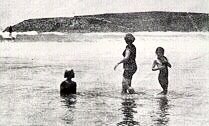 |
|
solid wood manner, January 1915. Myers: Freshwater LSC (1983) page 17. |
Freshwater Beach, January 1915. Myers: Freshwater LSC (1983) page 17. |
"Duke Kahanamoku, the celebrated swimmer from the Hawaiian Islands, and his swimming companion, George Cunha, and the manager of the tour arrived in Brisbane last night by the Sydney mail train."
-
Unaccredited: Swimming - Duke Kahanamoku - Arrival in
Brisbane.
The Brisbane
Courier, Friday 15 January 1915, page 3.
The original
board at the Freshwater Surf Lifesaving Club bears a plaque
noting the date as "February
1915''.
One of the
earliest published retrospective accounts of the Freshwater
exhibition on the 10th January was by C. Bede Maxwell in 1949.
Her account of
the offered assistance by the crew of the Manly surfboat has
often been repeated, however there is no confirmation in any
of the contemporary newspaper accounts and must be considered
likely to be an embellishment.
"... one
Sunday morning, he was ready.
A crowd
came down to the beach and sighed to see that, with its
usual perversity, the sea was big.
Manly
surfboat was making heavy weather of the trip around by
way of Queenscliff.
'But why
do we have the boat?' asked Kahanamoku curiously.
When
officials told him the boat was to tow his board out for
him the Hawaiian threw back his handsome head and roared
with laughter!
He picked
up his new board, ran with it down the beach, slapped it
down on a wave and made his way out through the break."
- Maxwell: Surf (1949) page 236.
Maxwell's account also included tandem riding, the un-named companion likely to have been Isabel Letham.
"Lastly
he picked up a local girl to bring her in before him,
tandem, to the shore.
That,
too, was something which had dismayed the orthodox when he
had been the first at Waikiki to venture it; the feat
involved the violation of the old taboo which denied
boards and canoes to women."
- Maxwell: Surf (1949) page 237.
Similarly,
this is not confirmed by contemporary newspaper accounts of
either of the two Freshwater exhibitions or the one at South
Steyne.
While Letham
did ride tandem with Duke in 1915, the only newspaper record
of a public performance is at the Dee Why Carnival, a month
later on 6 February 1915.
-
Unaccredited: Dee Why
Carnival.
Sydney
Morning Herald, 8th February 1915, page 13.
However it is
highly probable that Duke and Isabel did, at the least,
practice their tandem technique at Freshwater before venturing
to make a formal public appearance.
This is implied
in one announcement for the upcoming Dee Why Exhibition:
"Another achievement, so far alone mastered by him, is to take a passenger on the board with him."
Unaccredited:
Swimming
- Kahanamoku's Return.
Sydney
Morning Herald, 3rd February 1915, page 3.
Also note that
Maxwell's comment that "the feat involved the
violation of the old taboo which denied boards and canoes to
women" is strictly incorrect.
Polynesian
women were noted for their swimming and surfing abilities.
Furthermore,
Hawaiian legends suggest that a male and a female sharing a
wave may have been considered a preliminary to courtship.
***This
section needs to be cross checked with ...
Letham, Isabel:
Making Waves : Isabel Letham 1899 - 1995 (1996)
-can not find
my copy of this at present.
(Marion
Stell gives the same date Isabel Letham when recalling
her tandem riding with Duke Kahanamoku in an interview
with circa 1991.
records
the date as ' 6 February 1915' after interviews
with Isobel Lathem.
- Stell: Pam Burridge
(1992) page 7.) ????
- Certainly
Duke Kahanamoku and Isobel Lathem surfed together on this day,
but at Dee Why and not for the
first time.)
This was not
Letham's first public appearance in front of a large number of
spectators.
Twelve months
earlier at the first annual Dee Why Carnival, before crowd of
3000, she competed in a ladies surf race that ended with a
touch of drama, as reported by the Sydney Morning Herald:
"Only
two competitors- Miss Leatham and Miss Abrahams- started
in the ladies surf race.
The
latter however gave up before the shore was reached, and
had to be rescued."
-
Unaccredited: Dee
Why Carnival.
Sydney
Morning Herald, 16 February 1914, page 13.
According to the Manly Daily, Abrahams considered her "rescue" unneccessary:
"She afterwards denied that she had required the services of a life saver, stating that, having obtained a bad start, she was leisurely swimming ashore, and was rather annoyed at the attentions paid her by the life savers."
- S.&G.
Champion: Drowning,
Bathing and Life Saving (2000) page 197.
Citing Manly
Daily cuttings February 1914 in the Dee Why LS&S
Club minute book.
****
Maxwell largely "confirmed" Claude West's position as the first Australian expert surfboard rider:
"At camp
'Boomerang', ... Kahanamoku met enthusiastic youngster
Claude West.
West was
to become the Hawaiian's star pupil.
He
learned how to balance his board in deep water and to
develop skill in paddling, so necessary because a
surfboard, like a surfboat, must take a wave at speed if
it is to survive.
By the
time the kindly, generous instructor had left Australia,
Claude West had become the most proficient surf-rider on
the coast.
Annexing
the Australian championship in the same year, 1915, he
successfully defended this until 1925, contemporaries
swearing that surely young West had suckers on his feet."
- Maxwell: Surf (1949) page 237.
In 1915, there
was no national surfboard riding championships, indeed any
events in this period were best described as demonstration or
display events.
The earliest
confirmed contest success by Claude West was substantially
later- at the North Steyne Surfbathers Lifesaving Club
carnival on Saturday 6 December 1919, he won the surfboard
display competition with S. Dowling, also from Manly, in
second place.
-
Unaccredited: North
Steyne Carnival.
Sydney
Morning Herald, 8 December 1919, page 8.
Despite
numerous references to the surfboard riding exploits of
several of those associated with the Kahanamoku exhibitions in
the Sydney magazine The
Surf (1917-1918), Claude West is not mentioned.
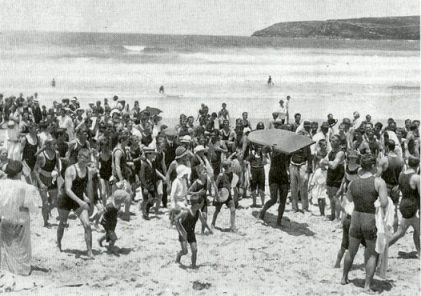 |
Possibly 10th January 1915. Click image for detailed analysis. i.
Young:History
(1983) page 47 ii.
Hall and Ambrose: Memories
of Duke (1995) page 40. |
"A
change was made in the Australian itinerary arranged for
Kahanamoku who is now well on his way to delight
Queensland folk.
He left
by the Brisbane express yesterday afternoon to fufill
eight engagements, which include shows at Allora and
Rockhampton."
- W.F.
Corbett: Kahanamoku
in
the Surf.
The Sun, 12th
January
1915, page 7.
Three days later, the journey presumably broken with an appearance at Allora, the party arrived in Bisbane on the 14th January.
"Duke Kahanamoku, the celebrated swimmer from the Hawaiian Islands, and his swimming companion, George Cunha, and the manager of the tour arrived in Brisbane last night by the Sydney mail train."
-
Unaccredited: Swimming - Duke Kahanamoku - Arrival in
Brisbane.
Brisbane
Courier, Friday 15 January 1915, page 3.
The tour
extended the length of the state, beginning with three
carnivals in Brisbane.
Brisbane First
Carnival, Saturday 16 January 1915.
- SMH 18
January 1915 page 5.
Between the carnivals, an excursion by boat was arranged for the visitors where:
"On
reaching the destination a large number enjoyed a
delightful swim, which was enlivened by the use of a polo
ball.
The
remainder enjoyed themselves with a football on the flat.
The
"Duke" preferred the latter pastime, at which he is no
mean adept."
-
Unaccredited: Swimming
-
River Trip to Kahanamoku.
Brisbane
Courier, Tuesday 19 January 1915, page 3.
Brisbane Second Carnival, Wednesday 20 January 1915.
"The second of the Kahanamoku carnivals will be held in the Dock, South Bribane, to-morrow evening.
- Brisbane Courier, Tuesday 19 January 1915 page 7.
Brisbane Third Carnival, Saturday 23 January 1915.
"Owing to the dock not being available the third and last of the Kahanamoku carnivals this will be held in the South Brisbane Baths this afternoon, commencing at 2.30"
- Brisbane Courier, Saturday 23 January 1915, page 6.
Rockhampton, Thursday 29 January 1915.
"A
successful swimming carnival was concluded to-night, Duke
Kahanamoku, George Cunha, Eric Pearce, and Sewell
participating."
.
- Unaccredited:
Hawaiians at Rockhampton.
Brisbane
Courier, Friday 29 January 1915 page 6
Allora
Maryborough
Mount Morgan
The party returned by train to Brisbane on Wednesday 3 February and the following day embarked on a coastal steamer for Sydney.
"The
members of the Hawaiian party, Duke Kahanamoku, George
Cunha, and Francis Evans (manager) - arrived by
yesterday's mail train from Mt. Morgan and
Rockhampton, and spoke appreciately of the treatment given
them.
They
continued their journey south by the Osterley, which left
the New Farm Whalf at 11 o'clock yesterday."
-Unaccredited:
Swimming
-
Depature of Kahanamoku.
The Brisbane
Courier, Thursday 4 February 1915 page 3.
While there
some unaccounted days in the itinerary during the ten day stay
in Brisbane, there does not appear to be any indication that
Kahanamoku travelled to the coast to experience the Queensland
surf.
"Messrs. D. P. Kahanamoku, George Cunha, and Francis Evans, the Hawaiian Swimming Team, who have been touring Queensland, returned to Sydney yesterday morning by the Osterley."
-
Unaccredited: Swimming -
Kahanamoku returns.
Sydney
Morning Herald, 6th February 1915, page 18.
While Duke Kahanamoku was touring Queensland, his boardriding exploits in Sydney continued to have an influence, sometimes not without controversy.
"Despite the continual outcry against surf-boards, the dangerous aids to shooters are still being used, and one last night at Coogee hit Mrs. Martha Green, aged 60, with such force that she is now in Prince Alfred Hospital with her right leg broken in two places."
-
Unaccredited: Surf Board
Injury.
The Sun, 24
January
1915, page 4.
"Last night Alderman Railton drew the Manly Council's attention to the dangers resulting from the careless use of surf boards at South Steyne."
-
Unaccredited: Dangerous
Surf Boards.
The Sun,
29 January 1915 page 2.
Meanwhile, Duke's swimming feats while in Australia were noted by the international press:
"A new mark for the 100 yard swim has been set by Duke Kahanamoku, the Honolulu champion, according to word received here today from Sydney, N.S.W."
-
Unaccredited: New Swim
Record.
New York
Times, January 26, 1915, Tuesday, page 9.
"Dee Why Club ... spent a lot of money to engage Duke Kahanamoku ... proving such an attraction to the paying public that in the thirty years afterwards the club did not succeed in matching that day's takings."
- Maxwell: Surf (1949) page 207.
An announcement of the upcoming exhibition noted that it would include a tandem surfing display, with Isabel Letham.
"The
champion sprinter and surf-board exponent will make hls
first public appearance In the surf at the Dee Why Club's
carnival, and if the waves be at all suitable, his
exhibitlon of board-rldlng in various attitudes should be
worth witnessing.
Kahanamoku
stands
upright on the board, and is also at home standing on his
head and balanclng in various positlons as the board
shoots towards the shore.
Another
achievement, so far alone mastered by him, is to take a
passenger on the board with him."
-
Unaccredited: Swimming -
Carnival Activity.
Sydney
Morning Herald, Wednesday 3rd February 1915, page 3.
The Dee Why
carnival was covered by all the Sydney papers.
The Daily
Telegraph rported on Duke's skills, including tandem riding.
It also
estimated the size of the crowd of spectators and the length
of the demonstrations, but apparently over-estimated the
length of the board.
"Duke
Kahanmoku treated something like 4000 persons to a fine
exhibition of surf board shooting at Deewhy on Saturday
afternoon.
...
Taking a
board something like 10 feet in length, the champion
swimmer made out towards the open sea.
...
When "the
Duke" stood up the sight was grand.
Later
Kahanamoku came in standing on his head, and at another
time carried a lady passenger.
For more
than an hour exhibitions were given."
-
Unaccredited: Kahanamoku
in
the Surf.
The Daily
Telegraph, 8th February 1915, page 4.
The reporter for the Sydney Morning Herald was similarly impressed and named Duke's tandem partner.
"He came
out with his surf board, plunged into the water and
continued to swim out until those watching from the beach
soon wondered when he would stop.
After
covering nearly half a mile, Kahanamoku turned and
prepared for a roller, which came along a moment after; he
caught it, and as the wave carried him shorewards he
performed all kinds of acrobatic feats on the board, and
finally dived into the water as the roller broke.
The crowd
showed their appreciation in a very hearty manner.
Kahanamoku
remained
in the surf for nearly an hour, and he was accompanied at
intervals by Miss Letham, of Freshwater, and it was a rare
sight to watch both swimmers on the surf board."
-
Unaccredited: Kahanamoku
and His Surf Board.
The Sydney
Morning Herald, 8th February 1915, page 13.
Ten days after the Dee Why event, Cecil Healey wrote a glowing report for The Referee, the heading proclaiming:
"Dexterity and Skill Win the Title 'Blondin of the Surf' "
Blondin, also
known as Chevalier Blondin, was born as Jean Francois Gravelet
in France in 1824, and gained a world-wide reputation as a
tightrope walker when he successfully crossed Niagara Falls in
June 1859.
In 1874 he made
highly profitable and much acclaimed tour of Australia,
performing in Brisbane, Sydney and Melbourne.
http://www.hat-archive.com/blondin.htm
He detailed the surfing performance at length, with some missgivings about the suitablity of the conditions:
"At the
time the Hawaiian put out to sea with his surf-board,
which he seems to worship almost as much as a child its
doll, the waves, unfortunately, were not particualy good
for shooting purposes, merely an occasional one having any
length of run.
The
rapidity with which he took the weighty plank out through
the breakers was not the least amazing feature of the
display.
...
On
sighting a likely-looking wave, he commenced to paddle
vigorously, still lying prone as before.
After a
few ineffectual attempts he succeeded in catching one
properly.
Instantly
the board seemed to leap forward like a fiery steed when
the spurs are driven into the rowels.
Immediately
afterward
the Duke rose upright, and assumed the attitude of ancient
chariot drivers.
And no
sooner had he done so than he appeared to exercise some
subtle influence over the madly careering craft : in fact
just as if he had taken reins in hand.
He
altered its direction so as to steer a course diagonal to
the beach.
Although
the prow pranced and bounded over the crest of the
onrushing billow, the Duke stood like an ebony statue,
immovable save for the deft movements of his feet, and
remained so until a few of the shore, when he leisurely
dropped off.
It was a
thrilling sight to watch, and such balancing skill and
dexterity entitles him to the designation of a surfing
Blondin."
Healey was less impressed with the display of tandem surfing:
"A young
lady acquaintance then emerged and accompanied the Duke
seawards.
It
occured to me at once if the Duke found it difficult to to
get going by himself with the not-by-any-means good waves
at his disposal, obviously his chances of doing so would
be greatly minimised when hindered by a novice.
Such
proved to be the case.
A
considerable time elapsed before he managed to get a move
on with his partner.
It must
be admitted, however, that the duel (sic, dual) shoot,
when it did come off, was the the more sensational
spectacle of the two while it lasted.
It served
to show more conspicuously the Duke's wonderful facility
for maintaining his equilibrium under these exacting
conditions, as although his passenger was toppling
backwards over the lattter part of their journey, the
extra burden failed to dislodge him until they had
negotiated about three-parts of the distance he covered
when alone.
But the
question arises whether the onlookers, many who had come
from distant suburbs, would not have been better pleased
to have been treated to a greater number of performances
like the first, rather than have to submit to the wearying
wait that occurred before the Duke found it possible to
bring off the more difficult stunt."
- Cecil
Healey: Duke in
the Surf.
The Referee,
16 February 1915, page 1.
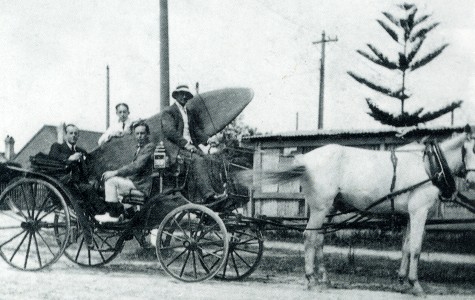 |
courtesy of The White Creamy Ponies. circa January - February 1915
|
"The white creamy ponies and carriages of Manly took up the van of the procession and were occupied by Mr F. W. J. Donovan (president), Mr A. W. Relph (secretary) and the committee of the club."
-
Unaccredited:Manly Surf
Carnival.
The Sydney
Morning Herald, Monday 21 March 1910, page 10.
"Duke
Kahanamoku, the 100 yds. world's champion swimmer, will
visit Cronulla Beach on Sunday afternoon and will give an
exhibition at 3 o'clock.
At the
invitation of the Cronulla Surf Club he will visit the
beauty spots of the Sutherland Shire."
-
Unaccredited:The
Surf Expert.
The
Propeller, Friday 5th February 1915, page 1.
There was a similar announcenent the following day in The St. George Call, Saturday 6th February 1915, page 5.
The Cronulla
Club undertook extensive preparations to ensure the day
was a success and to suitably honour their guest.
Upon leaving
the steam train at Sutherland, Duke Kahanamoku, George Cunha
and Francis Evans accompaned by Harry Hay, W.W. Hill and Don
McIntyre, were welcomed to the district by Club members and
then transported in members' cars to Audley via Waterfall and
Lady Carrington Drive.
After lunch at
Audley, the party travelled by ferry to Cronulla for the
surfing activities.
"An
alarm reel race was held, between the Duke, Cunha and Hay,
the linesman being made up of the clubmen.
There was
much guessing as to who the winner would be as the two
Hawaiins (sic)had never been in the belts before, and Hay
is one of the fastest beltmen in the State.
However,
the Duke made good use of his long legs in the wade out
and beat Hay by a yard.
Cuhna
could not get use to the belt and line at all, swimming a
crawl stroke he nearly wrenched his toes off, catching
them on the line.
The Duke
then adjourned to the big beach as there was more roll on
there, and gave an exhibition with his board that will be
long remembered by those who saw him.
Standing
upright, standing on his head, diving off, twisting the
board.
It all
looked so ridiculously easy, and so it was to the Duke,
but local men who tried after came to the conclusion that
they had a lot to learn about the game.
One wants
to try and stand on that unstable piece of wood, even in
smooth water, to appreciate fully the sight of that bronze
statue tearing in through broken and choppy seas."
The day concluded with further social activities:
"Tea was held in the new pavillion and the party adjourned to the captain's house for a couple of hour's music, the Duke and George Cuhna rendering an item in Hawaian (sic), the Duke providing the accompaniment on his eucalalia (sic, ukulele)."
-
Unaccredited: Cronulla
Surfing.
The St.
George Call, 13 February 1915, page 5.
According to W. G. Marshall, one of the boards shaped by Duke after the sugar pine Freshwater board made its way to Cronulla, the property of ex-Manly surf-shooter, Ron “Prawn” Bowden.
"The Duke's board later became the property of noted club member, Ron "Prawn" Bowden, who sold it to Fred Locke, who in turn, signed it over to the inimitable Jack McTigue."
- W.G.
Marshall: The
Cronulla SLSC Story, Part 2.
Cronulla Surf
Life Saving Club: Cronulla Surf Scene
Volume 1 Number
2 January, 1968, page 7.
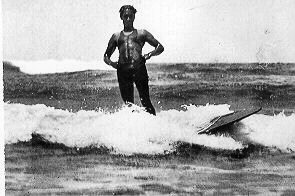 |
i. Warshaw:Surfriders (1997) page 30 |
Exacting
preparations for his 1915 visit were undertaken by the club
in an effort to make him feel at home. (1.)
The Duke and
his party were welcomed to the district by the club on
leaving the steam train at Sutherland.
Through the
generosity of club members, F. Stroud, J. Hallet, J. Munro,
L. Giddings, N. Bouffier and J. Hill Sr. making their cars
available the visitors were transported to Audley via
Waterfall and Lady Carrington Drive.
After lunch at Audley, the party joined the ferry to Cronulla, hence to the beach for surfing.
Tea was
arranged in the Park Pavillion after which the party
returned to Sutherland for the farewell ceremony.
The Duke
brought with him a surfboard (one of at least three made in
Australia) which he presented to the Surf Bathing
Association of NSW. (2.)
While there were already surfboard exponents on our own and other metroplitan beaches, Duke Kahanamoku first focused public attention on surfboard riding in NSW. (3.)
The visit
of this famous surfer also had effect on the local talent.
The Duke's
board (the one noted above) later became the property of
noted club member, Ron "Prawn" Bowden, who sold it to
Fred Locke, who in turn signed it over to the inimitable
Jack McTigue. (4.)
Jack, chivalrous character that he was, gave it to a certain beautiful surf siren but alas she married another (ungrateful hussey, recalls Jack).
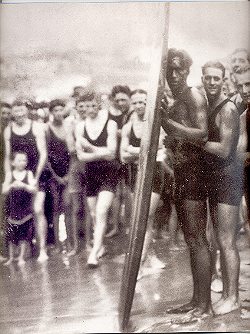
The article is
probably taken from a Cronulla Surf Life Saving Club history,
printed circa 1960 for the club's 50th anniversary (started
1909).
Similar
publications, jointly published/funded with the ASLA, are
known for Manly (Harris),
Freshwater
(Myers),
Deewhy
(Thomas)
clubs and the Illwawarra branch (Middleton).
It is less
probably from retrospective article in a small print run Club
magazine or newsletter.
The detail and
familiarity of the author with the participants indicate the
text was probably transcribed within 50 years of the events,
Duke Kahanamoku entered public office in 1934, and left in
1960, he suffered heart problems in 1956 and 1962 and
died in 1968.
Hence the
document is dated circa 1960.
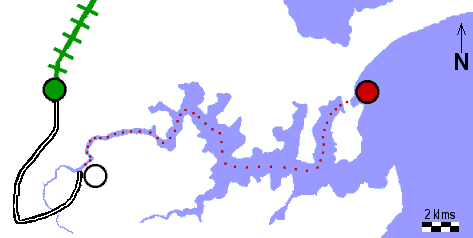 |
| Train
from Central station, Sydney to Sutherland |
Official
welcome and departure, Sutherland |
||
| Club Members' Cars, Sutherland to Audley via Waterfall | Lunch, Audley | ||
| Ferry, Audley to Cronulla | Surfing demonstration followed by tea at the Pavillion,Cronulla. Return by ferry. |
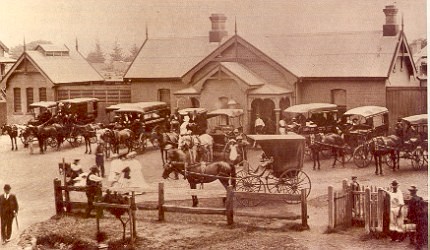
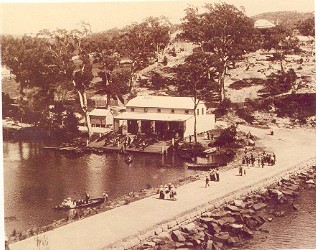
|
Audley, Royal National Park, 7 February 1915. On the way to the Cronulla exhibition. The
handwritten caption reads: Image
reprinted in
|
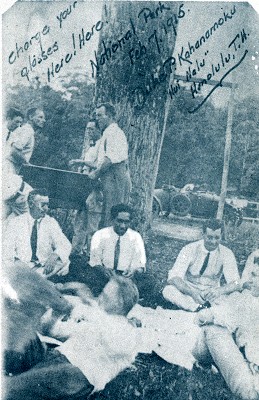 |
 |
Cronulla Beach, 7th February 1915. 1.
Warshaw : Surfriders
(1997) page 30 |

- Cecil
Healey: Duke in
the Surf.
The Referee,
16 February 1915, page 1.
- SMH 9
February 1915 p 12
- The
Sydney Morning Herald, Thursday 11 February 1915, page
13.
|
To Mr. E.S. Marks
E.
S. Marks was a prominant figure in many Sydney
sports. Postcard reproduced from private collection. |
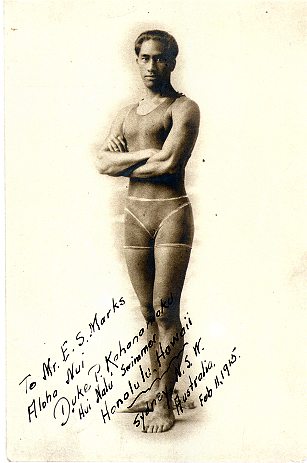 |
"The
Duke looked very fit as he left for Melbourne.
He had
just returned from the surf at Bondi, after some hard
battles with the rough breakers, which he explained, were
vastly different from those of his beloved Honolulu, which
roll in with a long, steady, sweeping roll.
The Duke
likes the surf play here; though it is different to
carvorting on the waves at Honolulu."
-
Unaccredited: (Swimming)
The Referee,
17 February 1915, page 16.
The visit to Bondi was most likely for body surfing.
On Saturday 13th February 1915, while the Kahanamoku party was in Victoria, at the Freshwater Club's Carnival, Manly Seagulls' Tommy Walker, who brought a surfboard from Hawaii in 1909-1910, was continuing with his exhibitions:
"The
display given by T. Walker on a "Duke" surf board was very
good indeed.
The canoe
and surf boat competitions provided some good
exhibitions."
-
Unaccredited: Swimming -
Kahanamoku's Records.
The Sydney
Morning Herald, Wednesday 17 March 1915, page 8.
The reference to "a 'Duke' surf board" probably means a Duke Kahanamoku type board, at a remote possibility, a new redwood board shaped by Duke himself.
The same day The Referee published a surfriding photograph from Waikiki.
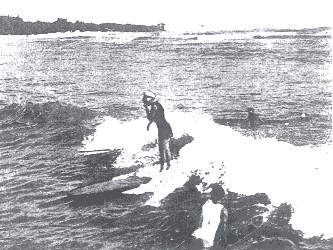 |
The
Referee |
"The executive had practically arranged another of raising a sum for patriotic purposes for Friday 19th, at which the Hawaiian party were to be made the means of adding to the price of admission by auctioning several surf boards made by themselves; but the departure of the Wellington boat on Friday, 19th February, instead of Saturday the 20th, has also made this impossible."
-
Unaccredited: Swimming -
Kahanamoku v Longworth.
Sydney
Morning Herald, 26 January 1915, page 10.
As Duke was arriving in New Zealand, at the Surf Bathing Association's gala at Bondi Beach on Saturday 20th March, his impact on surfboard riding continued:
"The introduction of a surf board exhibition during the latter competition was a good move, and brought out three very fine exponents."
-
Unaccredited: Swimming -
Surf and Other Carnivals.
The Sydney
Morning Herald, Wednesday 24 March 1915, page 8.
"Kahanamoku, Cunha, and Evans will compete at Auckland three times this week, and they will leave New Zealand on March 23 by the R.M.S. Niagara for Honolulu."
-
Unaccredited: Swimming -
Kahanamoku's Records.
The Sydney
Morning Herald, Wednesday 17 March 1915, page 8.
There was also the first of Duke's New Zealand surfing exhibitions:
"...
Hawaiian swimmer and surfer Duke Kahanamoku toured New
Zealand in 1915.
He gave
demonstrations at Muriwai on Auckland’s west coast, Lyall
Bay in Wellington, and New Brighton beach in
Christchurch.".
Nancy
Swarbrick: Lifesaving and surfing - The rise of
surfing.
Te Ara - the
Encyclopedia of New Zealand
http://www.TeAra.govt.nz/en/lifesaving-and-surfing/4
-
updated 2-Mar-09.
The Grey River Argus, clearly following the reports in the Sydney press, detailed Duke's surfing exploits across the Tasman and indicated the prospect of a similar display in New Zealand following the first Wellington carnival at the Te Aro Baths, Wellington, on 24th February.
"On a
surf-board Kahanomoku is supreme.
It is
stated that in his native islands he has shot the distance
of two miles upon one.
In Sydney
he had a special board made 8 feet long, 22 inches wide
and three inches.
It
weighed 83Ibs, and on it he frequently travelled half a
mile from out at sea to the beach.
At
Deewhy, near Manly, he has often taken a lady passenger on
board and shoots hundreds of yards.
He
performs the same feat standing on his head.
Wellington
swimmers
will probably have an opportunity of seeing Kahanamoku on
a surf-board at Lyall Bay on the Sunday following his
appearance in Te Aro baths."
-
Unaccredited: Duke
Kahanamoku's
Visit.
Grey River
Argus, 3 March 1915, page 3.
The appearance in the surf at Lyall Bay was a resounding success:
"A
record Sunday crowd attended Lyall Bay yesterday, in order
to see the famous swimmer, Duke Kahanamoku, in the surf.
The
people were well repaid.
The
visitor entertained them with a truly wonderful display of
shooting the breakers, which, after the spell of southerly
weather, were fairly large.
His
renowned standing shoot on the surf board was the
particular feature.
He stood
right up on the board, while the latter shot along at a
great speed.
By
careful steerlng he prolonged the shoot for a distance of
150 to 200 yards."
-
Unaccredited: (Lyall
Bay).
Evening Post,
Volume LXXXIX, Issue 56, 8 March 1915, page 6.
The Hawaiian party travelled to the South Island, for further swimming events and Duke gave another surfing demonstration at Brighton Beach, Christchurch.
"This photograph shows him either body surfing or preparing to stand on a board in the surf at New Brighton beach, Christchurch."
- Canterbury
Museum, Canterbury Times Collection
Reference:
1923.53.434
http://www.teara.govt.nz/en/lifesaving-and-surfing/4/1/2
As in
Australia, the surfboard riding demonstrations by Duke
Kahanamoku had an immediate impact on New Zealand surfers.
At the end of
the year the Poverty Bay Herald reported:
"Surf-riding
is
becoming more and more popular at Lyall Bay, Wellington.
Since the
visit of Duke Kahanamoku and his swimming partner, George
Cunha, and their notable exhibition of the art of riding
the surges, many swimmers have taken up the sport with
entusiasm.
Now it is
an every-day sight to see many bathers with surf-boards,
disporting themselves more or less skilfully on the
breakers."
-
Unaccredited: Untitled.
Poverty Bay
Herald, Volume XLII, Issue 13875, 24 December 1915, page
2.
Remarkably,
Duke Kahanamoku's surfboard riding displays in Sydney far
exceeded their influence on local surfers.
One of the
exhibitions was filmed for the cinema magazine Australasian
Gazette and was presumably shown around the
country, including at Spencer's Pictures at Launceston in
March 1915.
"The 'Australian Gazette' embraces the following topical subjects:- Sydney-Delfosse Badgery, the Australian aviator, does some most sensational flying at Victoria Park, including bomb-dropping. Melbourne- The state championship carnival; Duke Kahanamoku gives exhibitions on the surf board; and cartoons by Harry Julius, which form an entertainment by themselves."
-
Unaccredited: Amusements.
Examiner (Launceston),
Tuesday
16 March 1915, page 6.
The segment is
accredited as "Melbourne", probably because it was included
with footage of Duke at the Victorian "state championship
carnival".
Unfortunately,
the film is apparently now lost.
See:
Australian
Screen - Australasia Gazette
http://aso.gov.au/titles/collections/australasian-gazette/
Three years later, the impact of Duke Kahanamoku was still strong for Australian surfers:
"The
members of the Bondi and North Bondi Surf Clubs have
combined to hold a monster surf and beach carnival in aid
of Jack's Day at Bondi Beach on Saturday afternoon next.
The
programme will include exhibitions of surfboard riding by
pupils of Kahanamoku, and sensational canoe races through
the breakers."
-
Unaccredited: Jack's Day.
The Sydney
Morning Herald, Tuesday 29 October 1918, page 6.
| 1995 Hall,Sandra and Ambrose, Greg : Memories of Duke - The Legend Comes to Life The Bess Press PO Box 22388 Honolulu, Hawaii 96823, 1995 Soft cover, 145 pages, 131 black and white photographs, Glossary, Index. Review In-depth coverage of the many facets of Duke Kahanamoku's life story, including his Olympic career, film work in Hollywood and surfing around the world. Australian surfing exploits pages 36 to 45 - also note photographs on pages 12 and 13. Many of the images are found in a multitude of publications, though some are very rare. The historical format is slightly jumbled and there seems too much reliance on the input of wife, Nardine, who he did not meet and marry till 1940. Good, but still not the definite work on Duke Kahanamoku. See also: Kahanamoku with Brennan:World of Surfing Brennan: Duke |
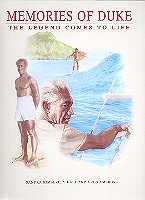 |
| 2004 Hall,Sandra : Duke - A Great Hawaiian The Bess Press 3565 Harding Avenue Honolulu, Hawaii 96816, 2004. Hard cover, 112 pages, 112 black and white photographs, Notes, Photo Credits, Further Reading, Index. Review Expertly written chronological account of the major highlights of Duke Kahanamoku's life story, including his Olympic career, film work in Hollywood and surfing around the world. The author maintains a fine balance between historical detail and personal insights of contemporaries. The first 30 pages outline Hawaiian history, Duke Kahanamoku's heritage and the resurgence of surfing. Australian surfing exploits pages 42 to 45. Simple, but very effective, format of full page image (many previously unpublished) with paired with a page of text. The beautiful design is complimented by the quality paper and binding. Excellent, but still not the definite work on Duke Kahanamoku. See also Kahanamoku with Brennan:World of Surfing (1968) Brennan: Duke (1994) Hall and Ambrose: Memories of Duke (1995) - above. |
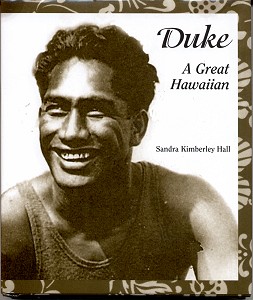 |

| home | catalogue | history | references | appendix |